Article courtesy of BEEFITSWHATSFORDINNER.COM.
Editor’s Note: The following blog, courtesy of BEEFITSWHATSFORDINNER.COM, addresses the nutritional value of beef as well as the cattle industry’s progress producing beef more sustainably. More information about Tyson Foods’ focus on beef sustainability can be found in a previous blog about the PROGRESSIVE BEEFprogram.
The Internet is flooded with trendy diets and conflicting advice on what a healthy diet is. The conversation has expanded beyond nutrition to consider whether the foods we eat are not only healthy but also sustainable – often leaving people confused about what is “good” and “bad” to eat.
To help cut through the confusion about what contributes to a healthy sustainable diet, Beef farmers and ranchers have worked using science and research to build a solid foundation. Using this research as a guide, we’ll look at how beef promotes health and helps prevent nutrient deficiencies (1), and the ways in which cattle play a unique role in our food system by upcycling inedible plants to high-quality protein (2, 3). All of these factors can impact your choices at the meat case and on the menu.
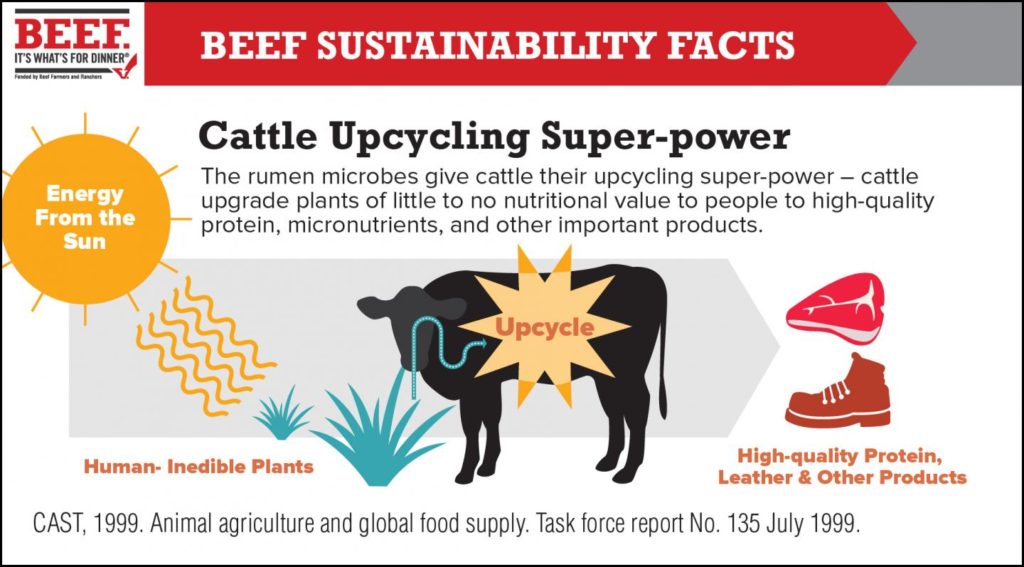
BEEF’S ROLE IN A HEALTHY DIET
Right now in America and other developed countries, it is common to be both overweight and, at the same time, undernourished. Why? We are surpassing recommended levels of calories, but we’re not balancing that with enough physical activity, and we’re not getting the recommended amounts of many important nutrients.
Beef – including steak, roasts and ground beef – offers a solution to this dilemma. It’s both delicious and it provides more nutrients in fewer calories than many other food choices. For example, a 3 oz serving of beef contributes over 50% of the daily value of protein and is also an excellent source of zinc, vitamins B6 and B12, niacin, and phosphorus and a good source of iron (14).
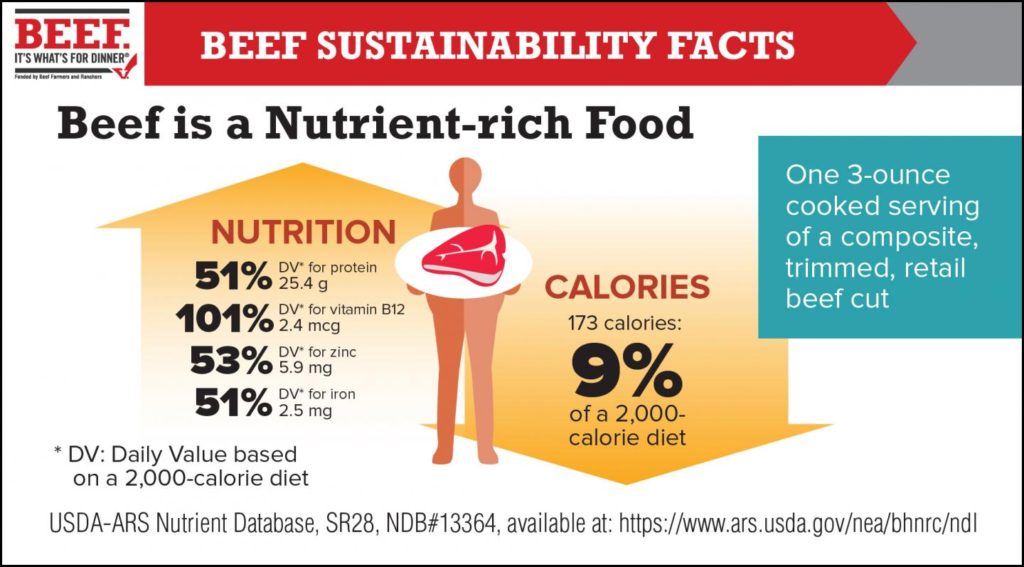
ALTERNATIVE PROTEINS: BETTER THAN REAL BEEF?
It seems like every time you open a health or fitness magazine, a celebrity is promoting the newest power protein food. And for good reason — a healthy, balanced diet includes protein from a variety of sources. While alternative proteins are gaining attention and space in the fridge and on plates, their perceived health benefits may not outweigh the nutritional consequences of not including lean meats in your diet.
Current diet fads like to tout the proteins in plant-based products. We like black beans, quinoa, and edamame too, especially when they are paired with a great beef meal. But they are no substitute for beef’s high-quality protein, which contains fewer calories and more nutrients.
A cooked 3 oz beef top sirloin steak averages about 156 calories while providing approximately 25 grams of protein (4), which is nearly half of the recommended daily value. To get the same exact amount of protein (25 grams), you’d need to eat six tablespoons of peanut butter (amount customarily consumed is 2 Tbsp) or a whopping three cups of quinoa (5) (amounts customarily consumed is about ¾ cup), for instance, which both also deliver a sizable amount of calories (564 calories for peanut butter; 666 calories for quinoa).
SUSTAINABLE FOOD SYSTEM: WOULD LESS BEEF BE BETTER?
Cattle are beneficial in a sustainable food system because of their unique stomach structure, which allows them to eat and digest what we as humans can’t. In addition to the grasses they graze on for most of their lives, they can eat numerous other byproducts from plant-based food production, such as brewers grains, pea pulp, beet tops, potato peelings and sunflower hulls, which are all byproducts of human activities or other products, such as PEA-PROTEIN burgers and meat crumbles. Instead of going to a landfill, cattle eat these “waste” products and turn them into a high-quality protein edible for human consumption.
Cattle also graze in areas where it’s impossible to grow crops, like the sand hills of Nebraska or the arid land of Nevada, taking those grasses and turning them into high quality protein, in places that could otherwise never be used to feed a growing population.
Many plant-based food advocates promote Meatless Mondays and vegan diets to reduce greenhouse gas emissions and lower their carbon footprint. However, research has demonstrated that removing all livestock and poultry from the U.S. food system would only reduce global greenhouse gas emissions by only 0.36 PERCENT.6 And further, if all Americans participated in Meatless Monday, U.S. greenhouse gas emissions would perhaps be reduced by 0.37 PERCENT (7). Removing beef from the diet would remove a high quality protein from diets, both in the U.S. and around the world.
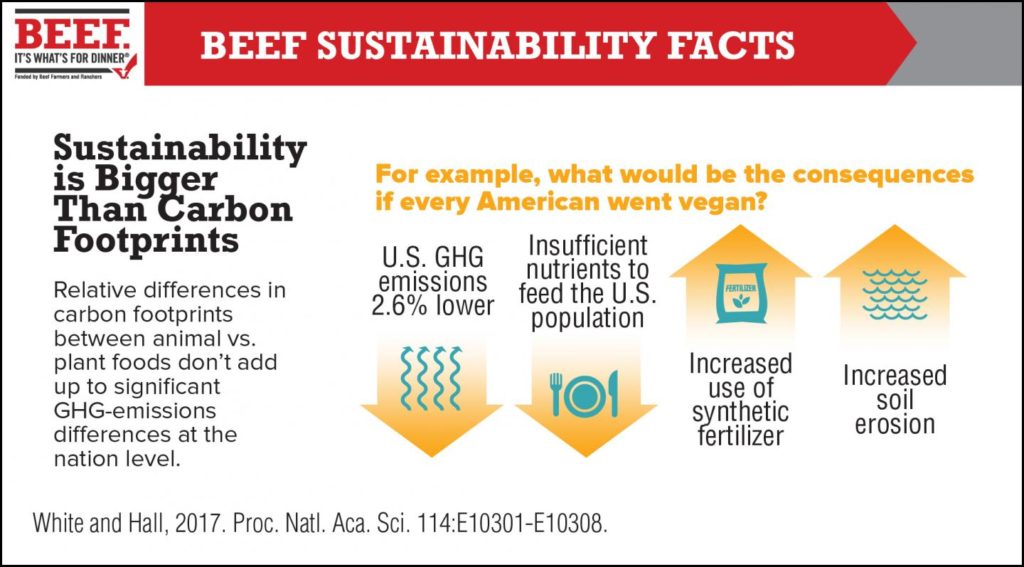
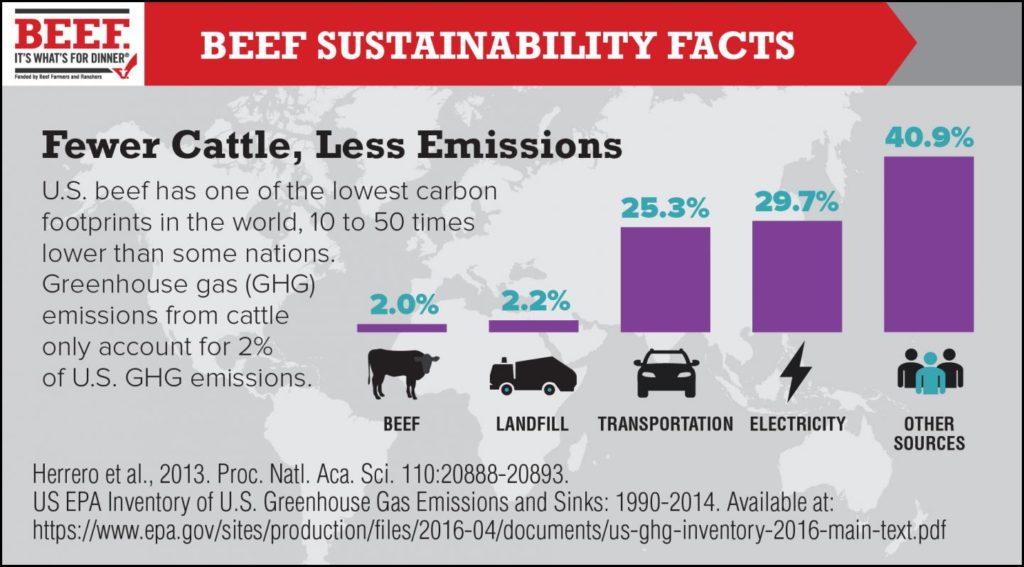
CONTRIBUTING TO A HEALTHY SUSTAINABLE DIET
The bottom line is that beef is nourishing and sustainable (8, 9, 10), and most people are already eating beef within global dietary guidelines (11). So, what can we all do to help make our diets healthier and more sustainable? There are three big opportunities that can make the biggest difference: waste less food, eat a balanced diet and improve the productivity of agriculture globally.
On average, 40% of all the food brought home in America goes uneaten, enough to fill a 90,000 seat Rose Bowl stadium every day, and that means food waste costs the average American family $2,500 annually (12, 13). If we wasted less beef, and less food in general, we would improve the environmental impact of our diets because that waste wouldn’t be emitting methane in a landfill. One great way to avoid food waste is using ingredients you already have to make a new meal or eating “plannedovers” to re-create leftovers.
We can also eat a balanced diet to contribute a healthy and sustainable food supply. We know that on average, 3 ounces of cooked beef provides 10 essential nutrients in about 170 calories including 25 grams of high quality protein, zinc, iron, and B vitamins (14). Beef packs a nutrient punch that can’t afford to be lost. By eating a variety of whole grains, fruits, vegetables, and lean proteins – and not wasting it – we can create a sustainable food system that will support a growing global population, so all people can thrive.
When it comes to productivity, in the U.S., we produce the same amount of beef today with 33% FEWER cattle compared to 1977, and 18% of the world’s beef with only 8% of the world’s cattle. This is a result of better animal health and welfare, better animal nutrition and better animal genetics, all of which are supported by the BEEF QUALITY ASSURANCE PROGRAM. Beef farmers and ranchers also rely on experts like nutritionists and veterinarians focused to support herd health and production.
As we work together to build a healthier, more sustainable food supply for ourselves and future generations, our focus should be on changes that are science-based, practical and highly impactful, like reducing food waste, consuming balanced meals and improving global agricultural productivity.
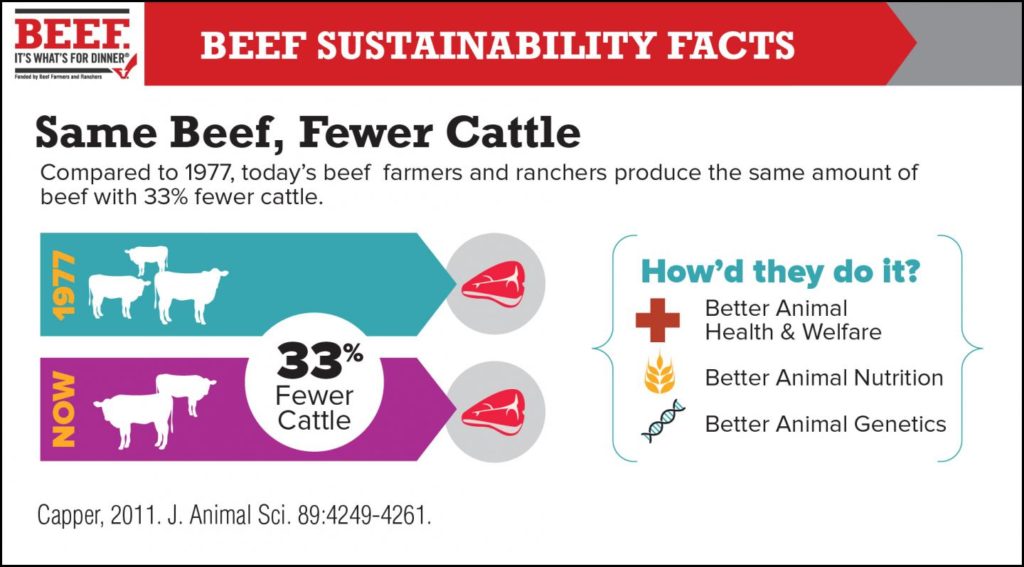
- McNeill S, Van Elswyk ME. Red meat in global nutrition. Meat Sci. 2012 Nov;92(3):166-73. doi: 10.1016/j.meatsci.2012.03.014. Epub 2012 Apr 1.
- National Academies of Sciences, Engineering, and Medicine. 2016. Nutrient Requirements of Beef Cattle: Eighth Revised Edition. Washington, DC: The National Academies Press. HTTPS://DOI.ORG/10.17226/19014
- Council for Agricultural Science and Technology (CAST). 1999. Animal Agriculture and Global Food Supply. Task force report N. 135 July 1999, Department of Animal Science, University of California, Davis, CA, USA.
- USDA National Nutrient Database for Standard Reference, ID # 13454
- USDA National Nutrient Database for Standard Reference, ID # 16167 and ID # 20137
- White and Hall, 2017
- White and Hall, 2017
- White, RR, Hall MB. Nutritional and greenhouse gas impacts of removing animals from US agriculture. Proc Natl Acad Sci U S A. 2017 Nov 28;114(48):E10301-E10308.
- United States. Department of Health and Human Services., United States. Department of Agriculture., United States. Dietary Guidelines Advisory Committee. Dietary guidelines for Americans, 2015-2020. Eighth edition. ed. Washington, D.C.: U.S. Department of Health and Human Services and U.S. Department of Agriculture; 2015. HTTPS://WWW.CDC.GOV/NCHS/DATA/HESTAT/OBESITY_ADULT_07_08/OBESITY_ADULT_07_08.PDF
- US Department of Agriculture, Agricultural Research Service, Nutrient Data Laboratory. USDA National Nutrient Database for Standard Reference, Legacy. Version Current: April 2018. Internet: /nea/bhnrc/ndl
- McNeill S, Van Elswyk ME. Red meat in global nutrition. Meat Sci. 2012 Nov;92(3):166-73. doi: 10.1016/j.meatsci.2012.03.014. Epub 2012 Apr 1.
- Sustainability Executive Summary, BeefBoard.org, 2015
- 1. Food Waste: The Facts, WorldFoodDay.org, 2015. Food Waste Facts in the U.S.
- USDA National Nutrient Database for Standard Reference, ID#13364
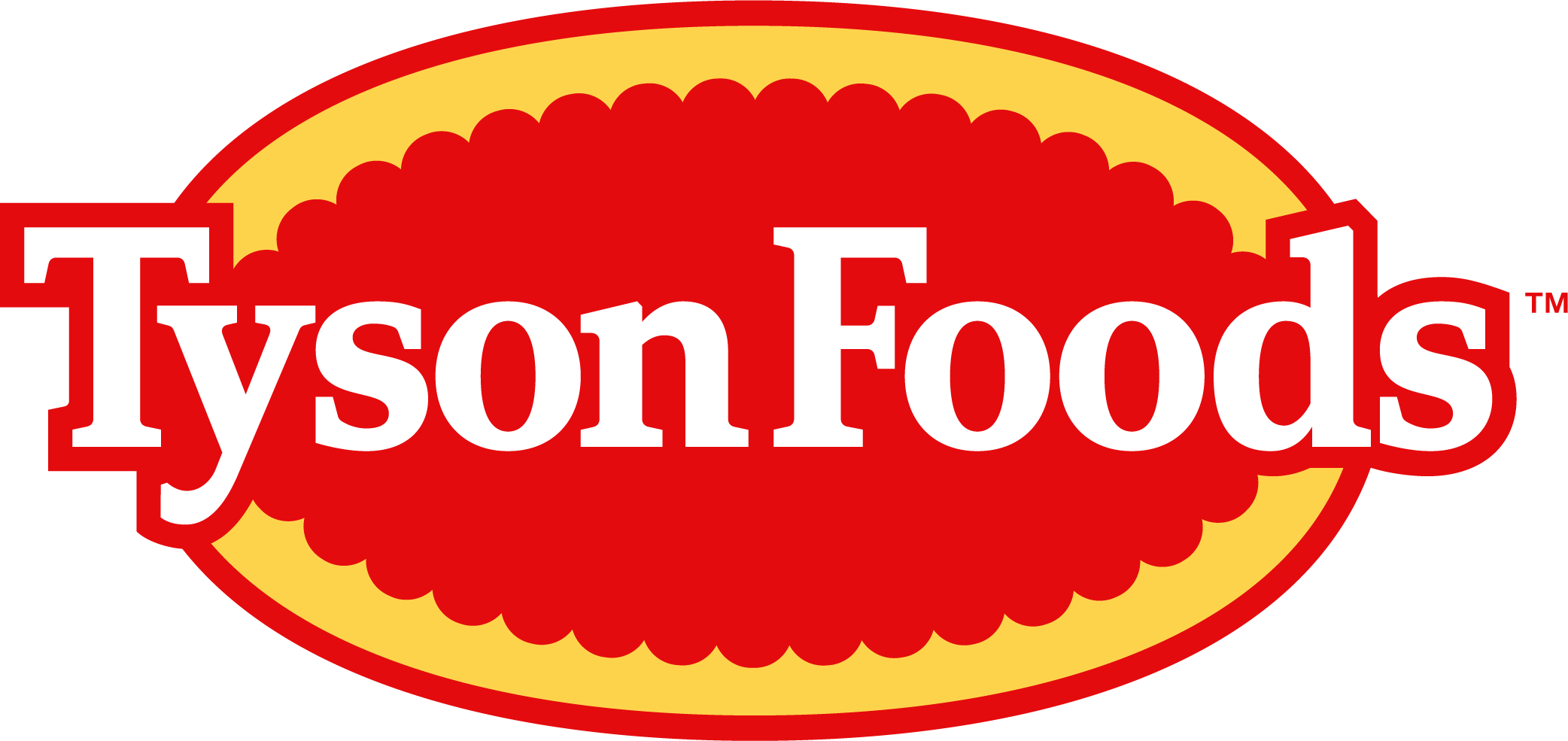
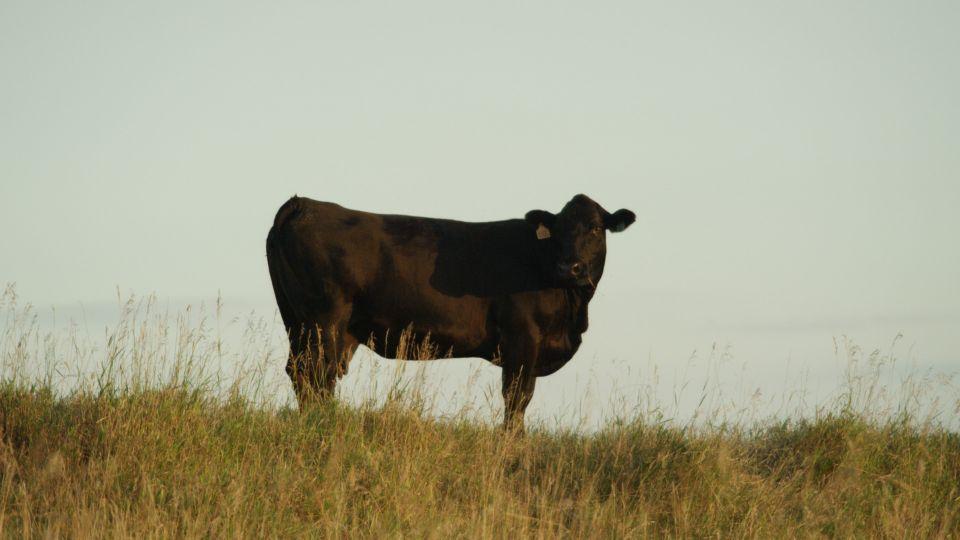




1 Comment
I like how you said that beef is sustainable and nourishing to the body. Eating steak is actually beneficial to your body because of the nutrients and proteins it provides. Thanks for emphasizing how beef is actually good for the body.
Leave A Comment